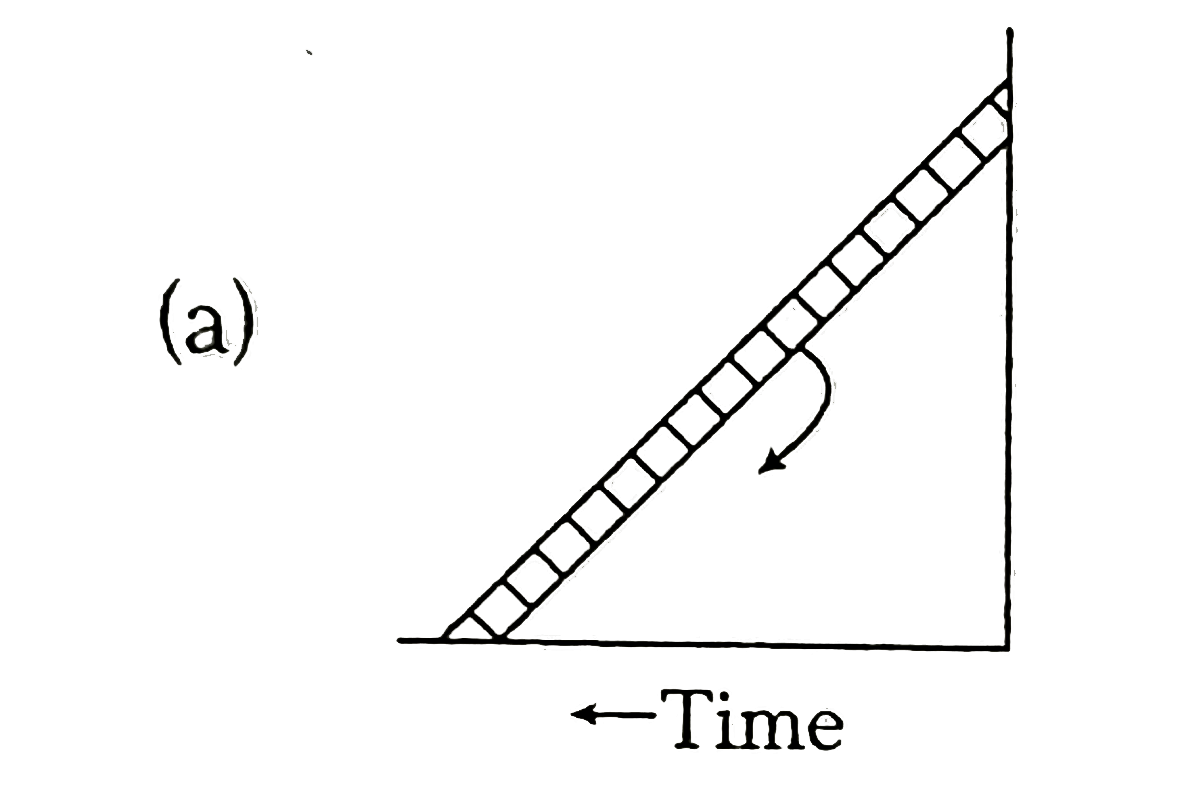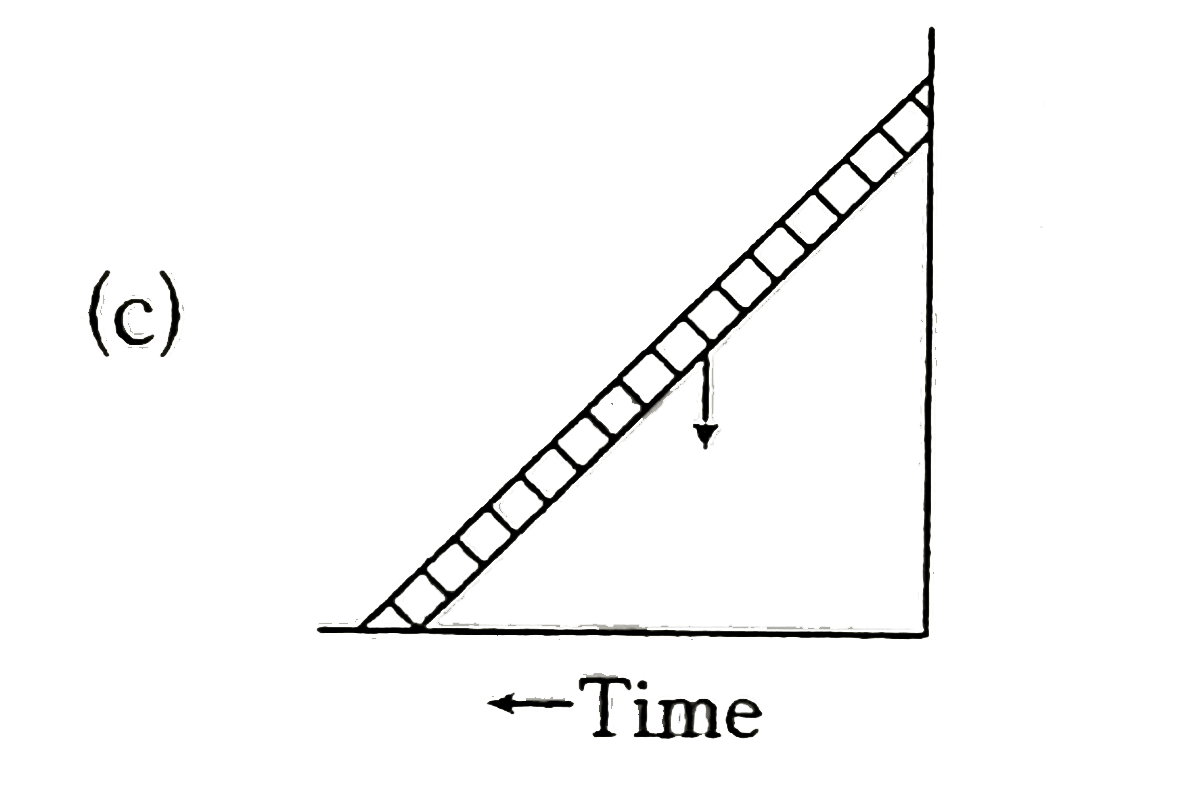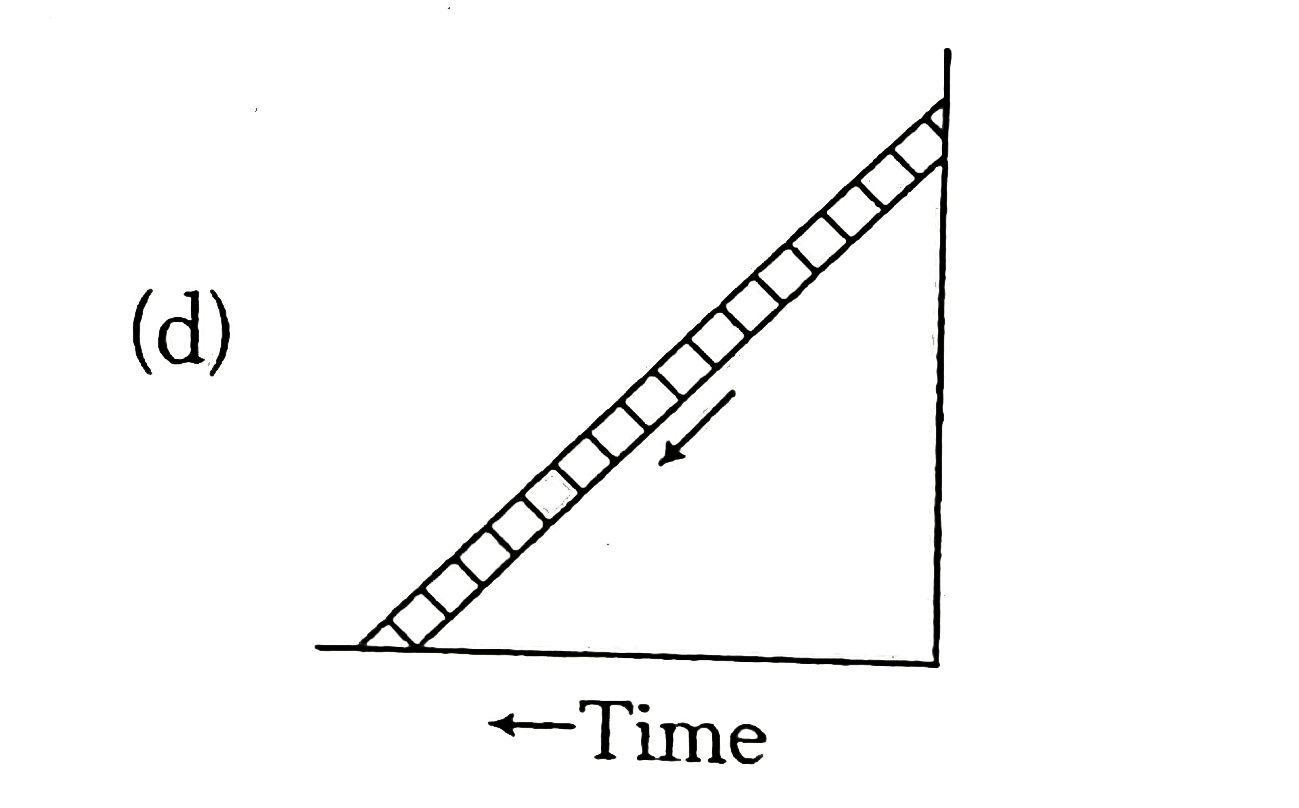A ladder is leaned against a smooth wall and it is allowed to slip on a frictionless floor. Which figure represents the track of its centre of mass ?




The correct Answer is:A
To solve the problem of determining the track of the center of mass of a ladder leaning against a smooth wall and slipping on a frictionless floor, we can follow these steps:
Step 1: Understand the System
We have a ladder leaning against a wall, with one end on the floor and the other end touching the wall. The wall is smooth, meaning there is no friction, and the floor is also frictionless. This means that the ladder can slide down without any resistance.
Hint: Visualize the ladder's position and the forces acting on it.
Step 2: Identify the Forces
The forces acting on the ladder include:
- The gravitational force acting downward at the center of mass of the ladder (mg).
- The normal force exerted by the wall acting horizontally.
- The normal force exerted by the floor acting vertically.
Hint: Draw a free-body diagram to help visualize the forces.
Step 3: Motion of the Center of Mass
As the ladder slips, the center of mass will move in a specific path. Since the wall is smooth and the floor is frictionless, the center of mass will not experience any horizontal force, and its vertical motion will be influenced only by gravity.
Hint: Consider how the center of mass behaves under the influence of gravity and the constraints of the wall and floor.
Step 4: Analyze the Path
The center of mass of the ladder will follow a curved path as the ladder slides down. The vertical position of the center of mass will decrease while the horizontal position will change as the ladder slides down the wall.
Hint: Think about the trajectory of a point mass under the influence of gravity and how it relates to the ladder's position.
Step 5: Determine the Correct Figure
From the options provided, we need to find the figure that best represents the path of the center of mass. The correct figure will show a downward curve that reflects the motion of the center of mass as it descends while the ladder slips.
Hint: Look for a figure that shows a downward curve, indicating the center of mass is moving downward as the ladder slides down.
Conclusion
After analyzing the situation, we conclude that the correct representation of the track of the center of mass is option C, which shows the downward trajectory of the center of mass as the ladder slips.
Final Answer: The correct option is C.
---
We have a ladder leaning against a wall, with one end on the floor and the other end touching the wall. The wall is smooth, meaning there is no friction, and the floor is also frictionless. This means that the ladder can slide down without any resistance.
The forces acting on the ladder include:
- The gravitational force acting downward at the center of mass of the ladder (mg).
- The normal force exerted by the wall acting horizontally.
- The normal force exerted by the floor acting vertically.
As the ladder slips, the center of mass will move in a specific path. Since the wall is smooth and the floor is frictionless, the center of mass will not experience any horizontal force, and its vertical motion will be influenced only by gravity.
The center of mass of the ladder will follow a curved path as the ladder slides down. The vertical position of the center of mass will decrease while the horizontal position will change as the ladder slides down the wall.
From the options provided, we need to find the figure that best represents the path of the center of mass. The correct figure will show a downward curve that reflects the motion of the center of mass as it descends while the ladder slips.
After analyzing the situation, we conclude that the correct representation of the track of the center of mass is option C, which shows the downward trajectory of the center of mass as the ladder slips.
Topper's Solved these Questions
- CENTRE OF MASSBOOK - DC PANDEY ENGLISHCHAPTER - CENTRE OF MASSEXERCISE - Assertion and reason
21 Videos
- CENTRE OF MASSBOOK - DC PANDEY ENGLISHCHAPTER - CENTRE OF MASSEXERCISE - Match the coloumns
9 Videos
- CENTRE OF MASSBOOK - DC PANDEY ENGLISHCHAPTER - CENTRE OF MASSEXERCISE - Check points
50 Videos
- CALORIMETRY AND HEAT TRANSFERBOOK - DC PANDEY ENGLISHCHAPTER - CALORIMETRY AND HEAT TRANSFEREXERCISE - Medical entrance s gallery
38 Videos
- CENTRE OF MASS, IMPULSE AND MOMENTUMBOOK - DC PANDEY ENGLISHCHAPTER - CENTRE OF MASS, IMPULSE AND MOMENTUMEXERCISE - Comprehension type questions
15 Videos
Similar Questions
A disc of mass M and radius R has a spring of constant k attached to its center , the other end of the spring being fixed to a vertical wall. If the disk rolls without slipping on a level floor, how far to the right does the centre of mass move , if Initially the spring was unstretched and the angular speed of the disc was ω0

View SolutionThe length of a uniform ladder of mass m is 1. It leans against a smooth wall making an angle θ with the horizontal. What should be the force of friction between the floor and ladder so that the ladder does not slip ?
View SolutionA ladder of length 5m is placed against a smooth wall as shown in figure. The coefficient or friction is μ between ladder and ground. What is the minimum value of μ , If the ladder is not to slip?

View SolutionA ladder of length 5m is placed against a smooth wall as shown in figure. The coefficient or friction is μ between ladder and ground. What is the minimum value of μ , If the ladder is not to slip?

View SolutionIf a ladder is not in balance against a smooth vertical wall, then it can be made in balance by :-
View SolutionA light stick of length l rests with its one end against the smooth wall and other end against the smooth horizontal floor as shown in the figure. The bug starts at rest from point B and moves such that the stick always remains at rest. aP is the magnitude of acceleration of but of mass m, which depends upon its distance of x from the top end of the stick. Choose the correct option (s)

View SolutionA rope thrown over a pulley has a ladder with a man of mass m on one of its ends and a counter balancing mass M on its other end. The man climbs with a velocity vr relative to ladder. Ignoring the masses of the pulley and the rope as well as the friction on the pulley axis, the velocity of the centre of mass of this system is:
View SolutionA uniform ladder of length 3.25 m and weight 250 N is placed against a smooth vertical wall with its lower end 1.25 m from the wall. If coefficient of friction between the ladder and the floor is 0.3, then, find the frictional force acting on the ladder at the point of contact between ladder and floor.
View SolutionA ladder 5m long rests against a vertical wall. If its top slides down at the rate of 10cm/sec, then, when the foot of the ladder is 4m away from the wall, the angle between the floor and the ladder is decreasing at the rate of
View SolutionThe ladder shown in figure has negligible mass and rests on a frictionless floor. The crossbar connects the two legs of the ladder at the middle. The angle between the two legs is 600. The fat person sitting on the ladder has a mas of 80 kg. Find the contact force exerted by the floor on each leg and the tension in the cross bar.

View Solution
